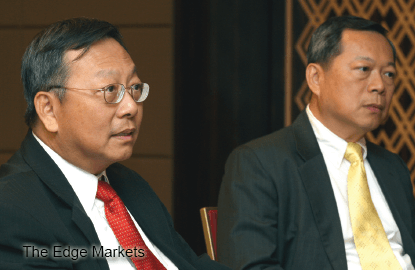

JOHOR-BASED oil palm planter Kim Loong Resources Bhd may see a 10% decline in earnings in its financial year ending Jan 31, 2016 (FY2016), no thanks to lower crop yield and weaker commodity prices, but there is nothing to stop the cash-rich company from distributing higher dividends.
“We have a lot of cash reserves and we are seeing a surplus every year. Since there is no major capital expenditure and expansion plan this year, I think we can be a bit more generous in rewarding the shareholders,” executive chairman Gooi Seong Lim tells The Edge.
Kim Loong (fundamental: 2.80; valuation: 2.40) declared a total dividend per share (DPS) of 13 sen in FY2015 (see table) on a payout ratio of 53.7%, giving its shareholders a dividend yield of 4.8% based on its closing price of RM2.70 last Thursday.
The company was picked by InsiderAsia as its stock of the day on June 19. InsiderAsia believes Kim Loong will continue to pay higher than market average dividends as it has a healthy balance sheet and relatively steady earnings.
“Its dividend payout ratio has ranged from 50% to 70% of annual net profit in the past five years. We believe this payout ratio is sustainable going forward,” it said.
Kim Loong has been paying dividends since 2001 and over the last five years, its annual DPS has ranged from 10 sen to 16 sen.
Interestingly, Kim Loong’s net cash stood at RM235 million as at Jan 31, which translates into net cash per share of 75 sen. This also represents 28% of its current market capitalisation of RM840.4 million.
Its cash and equivalents have been growing steadily, from RM188 million in FY2012 to RM272 million in FY2015. Meanwhile, its gearing ratio remains low at 0.08 times.
Kim Loong managing director Gooi Seong Heen, who is Seong Lim’s younger brother and was also present at the interview, says the group may report weaker results in FY2016 as its profit could be dampened by lower fresh fruit bunch production yield and weaker crude palm oil (CPO) prices. “[Our profit in FY2016] should be slightly lower but, hopefully, the decline can be maintained at around 10%.”

The company’s net profit rose 23% year on year to RM75.4 million in FY2015 while revenue grew 21% to RM774.8 million.
Moving forward, says Seong Heen, the dry weather is expected to affect Kim Loong’s crop yield and hence its bottom line in FY2016. “That is something we worry about. Our latest bunch count shows that it’s going to be flat for the rest of the year, so production could be lower than in FY2015.”
Crop yield and production remained positive in FY2015 with the company recording FFB yield of 22.49 tonnes per hectare, which was higher than the industry average of 18.63 tonnes, while FFB production grew to 304,732 tonnes from 287,188 tonnes a year earlier.
A family-run plantation firm, Kim Loong is 64%-owned by the Gooi brothers Seong Lim, Seong Heen, Seong Chneh and Seong Gum. The last two sit on Kim Loong’s board as executive directors.
It is worth noting that the four brothers own more than a 62% stake in Johor-based property developer Crescendo Corp Bhd (fundamental: 2.70; valuation: 2.40).
Kim Loong has more than 15,000ha of oil palm plantations (93% fully planted) in Sabah, Sarawak and Johor. In Sarawak, it also has a potential 3,600ha of plantable native customary rights (NCR) land and state land to be secured and developed within two to three years.
The group has a palm oil mill each in Kota Tinggi, Johor, and Keningau and Telupid in Sabah, with total FFB processing capacity of one million tonnes a year.
Currently, its plantation segment contributes about 60% to group profit while the remaining 40% comes from its milling operation.
Seong Heen admits that there are limited opportunities for Kim Loong to expand its plantation landbank in Malaysia but adds that the group has no intention of venturing abroad. “We haven’t been able to find new land [in Malaysia] so far. Thus, the company has a lot of cash reserves to deploy. There is land overseas but we are not interested.”
Seong Lim says the company is selective about expanding its plantation operation. “We have optimised what we have; there is no land to buy at the moment.” 
On the company’s milling operation, Seong Heen says it plans to build its fourth mill in Pantu, Sarawak, by 2017, which is expected to provide an additional FFB processing capacity of 300,000 tonnes a year. “If we can get the relevant approvals by next year, we hope to build and run the new mill by the middle of 2017. One mill will easily cost us about RM60 million.”
Commenting on the CPO price, he says it is unlikely to go higher than last year’s level. “Half a year is already gone and we are still at RM2,200 per tonne. CPO price could be higher in the second half of the year but most likely it will only pull up to RM2,300 per tonne.”
Note: The Edge Research’s fundamental score reflects a company’s profitability and balance sheet strength, calculated based on historical numbers. The valuation score determines if a stock is attractively valued or not, also based on historical numbers. A score of 3 suggests strong fundamentals and attractive valuations. Visit www.theedgemarkets.com for more details on a company’s financial dashboard.
This article first appeared in The Edge Malaysia Weekly, on June 29 - July 5, 2015.
Save by subscribing to us for your print and/or digital copy.
P/S: The Edge is also available on Apple's AppStore and Androids' Google Play.